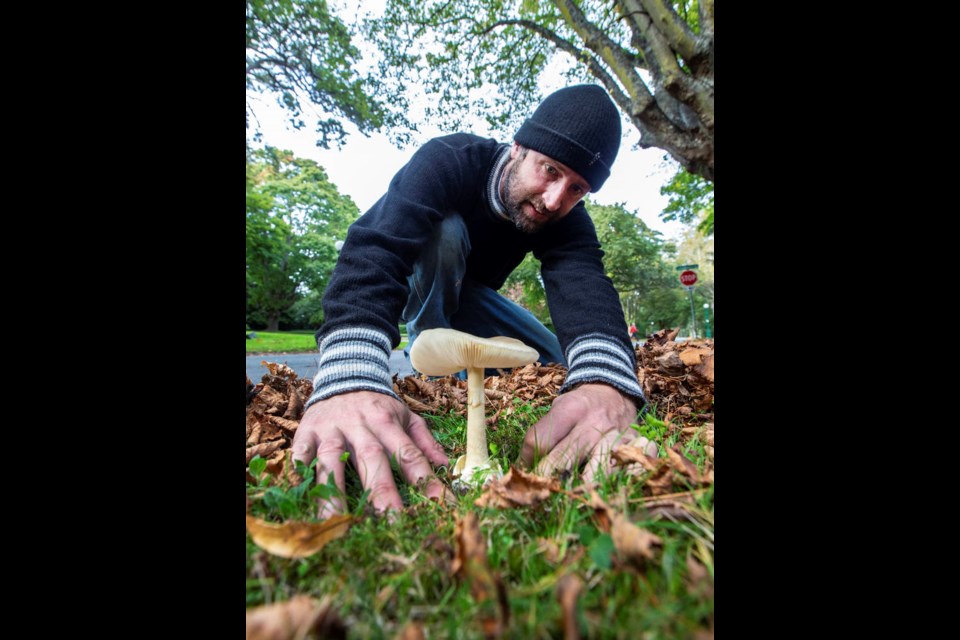When amateur mycologist Jason Gowen crouches down over a death cap mushroom, he doesn’t just see the grave risk, but also the beauty: the smoothness of its cap and the chemical lab within its fruiting body.
The Vancouver Island Mycological Society member tracks the deadly mushroom on boulevards and lawns in Greater Victoria and runs mushroom identification workshops and webpages. He also volunteers for a group that identifies mushrooms following accidental ingestion.
The B.C. Centre for Disease Control is warning people to watch for the lethal death caps, which fruit from June through December, especially after heavy rains, in urban areas of the Island and Lower Mainland. If ingested, the mushrooms — Amanita phalloides — can cause organ failure and death.
The warning is important because the pandemic is pushing people outdoors, where many are taking an increased interest in foraging for mushrooms, said Island Health chief medical health officer Richard Stanwick, who notes the mushroom is as lethal to dogs as it is to people. “Life is stressful enough right now and we don’t want to add to that excessively, but we need to let people know there are some things they may wish to avoid.”
There are about 250 species of wild mushrooms in North America that are poisonous, but the death cap accounts for 90 to 95 per cent of mushroom-related deaths, Stanwick said.
The deathcap’s telltale characteristics include a greeny-bronze cap, a veil around the stem, white gills and a distinctive, bulbous volva or cup at the base of the stem. Despite those characteristics, it’s often mistaken for other mushroom varieties.
Gowen, who answers inquiries on various mycology social media sites, estimates that about 90 per cent of people who think they have death caps don’t.
But mycologists report easily finding the death cap throughout Greater Victoria. Gowen says they are most prolific in urban centres because of the maturity and diversity of the trees that death caps depend on, largely hardwoods such as oak, hornbeam, beech, chestnut, birch and filbert. In recent years, the mushrooms have been found with Garry oak trees.
Even when removed, the mushrooms will grow back. Once an ectomycorrhizal fungus is in the ground, it can’t be removed, even by taking out the tree, which is why education is so important, Gowen said.
Gowen, who uses a dog-poop bag and a butter knife when removing a fruiting mushroom for study, said he is recording its prevalence year over year in a particular patch in Oak Bay.
“It’s progressing along that street in greater numbers every season.”
The death cap was introduced to North America from Europe. The first in Canada was recorded in 1997 near an imported European sweet chestnut tree in Mission. The following year, one was found on the grounds of a government building in Victoria under a large ornamental European beech tree.
The mushrooms are now numerous in southwestern B.C., growing on urban boulevards, lawns and parks.
Dr. Raymond Li, a pharmacist at the B.C. Drug and Poison Information Centre, said on average, the centre gets 200 to 250 calls each year about exposures to wild mushrooms, about 27 per cent of which result in illness.
There have been three serious death cap poisonings of humans on the Island, Stanwick said.
In 2003, a man mistook the death cap for a puffball “because the immature ones can look similar,” Stanwick said, while a woman in 2008 mistook the death cap for a straw mushroom, a tasty mushroom common in South Asia. Both survived.
The deadly amotoxin poison needs to get into the intestinal tract to take effect. Even with prompt treatment in hospital, up to 30 per cent die after eating a death cap mushroom.
In 2016, a three-year-old child died after eating a death-cap mushroom picked on a Victoria boulevard, “literally a block and a half from the Ministry of Health building” on Blanshard Street, Stanwick said.
This year in B.C., there have been “two close calls” where toddlers picked up mushrooms that were later identified as death caps, and put them near or in their mouths, nibbled, but didn’t ingest them, Li said. “The mushroom was retrieved mostly intact.”
Last year, there were also dogs and cats poisoned by death caps, Li said, including two puppies in Greater Victoria.
Simply handling a death cap is not considered dangerous, but health officials advise using disposable gloves, and throwing them in the garbage, not the compost. They note that cooking the death cap mushroom does not render the toxins inactive.
Mycologist Paul Kroeger says foragers need to obey one basic rule: “Never eat anything that hasn’t been identified with certainty; a mistake can have serious or even deadly consequences.”
Li advises joining a mushroom club, as he has done, foraging with experienced experts and consulting well-established identification websites.



